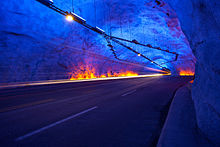Lærdal Tunnel
 |
|
| Overview | |
|---|---|
| Location | Sogn og Fjordane, Norway |
| Coordinates | 60°58′19″N 07°22′06″E / 60.97194°N 7.36833°ECoordinates: 60°58′19″N 07°22′06″E / 60.97194°N 7.36833°E |
| Route | E16 |
| Operation | |
| Work begun | 1995 |
| Opened | 2000 |
| Operator | Norwegian Public Roads Administration |
| Character | Automotive |
| Vehicles per day | 1,000 |
| Technical | |
| Length | 24.51 km (15.23 mi) |
| Highest elevation | 265 m (869 ft) |
| Lowest elevation | 5 m (16 ft) |
| Width | 9 m (30 ft) |
| Grade | 2.5% |
The Lærdal Tunnel (Norwegian: Lærdalstunnelen) is a 24.51-kilometre (15.23 mi) long road tunnel connecting Lærdal and Aurland in Sogn og Fjordane, Norway and located approximately 175–200 kilometres (109–124 mi) north-east of Bergen. It is the longest road tunnel in the world succeeding the Swiss Gotthard Road Tunnel. The tunnel carries two lanes of European Route E16 and represents the final link on the new main highway connecting Oslo and Bergen without ferry connections and difficult mountain crossings during winter.
In 1975, the Parliament of Norway decided that the main road between Oslo and Bergen would run via Filefjell. In 1992, Parliament confirmed that decision, made the further decision that the road should run through a tunnel between Lærdal and Aurland, and passed legislation to build the tunnel. Construction started in 1995 and the tunnel opened in 2000. It cost 1.082 billion Norwegian krone ($113.1M USD).
A total of 2,500,000 cubic metres (3,300,000 cu yd) of rock was removed from the tunnel during its construction from 1995 to 2000. The tunnel begins just east of Aurlandsvangen in Aurland and goes through a mountain range and ends 5.5 kilometres (3.4 mi) south of Lærdalsøyri in Lærdal. The design of the tunnel takes into consideration the mental strain on drivers, so the tunnel is divided into four sections, separated by three large mountain caves at 6-kilometre (3.7 mi) intervals. While the main tunnel has white lights, the caves have blue lighting with yellow lights at the fringes to give an impression of sunrise. The caves are meant to break the routine, providing a refreshing view and allowing drivers to take a short rest. The caverns are also used as turn around points and for break areas to help lift claustrophobia during a 20-minute drive through the tunnel. To keep drivers from being inattentive or falling asleep, each lane is supplied with a loud rumble strip towards the centre.
...
Wikipedia
